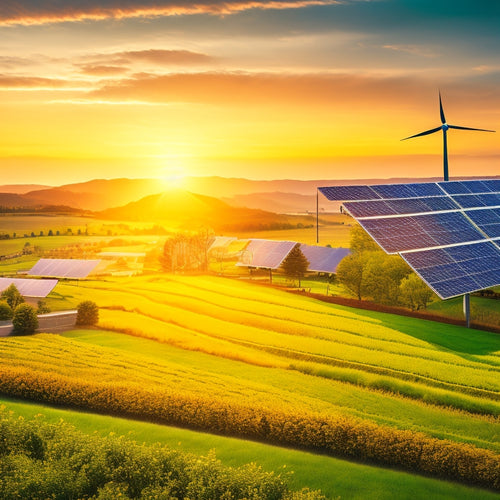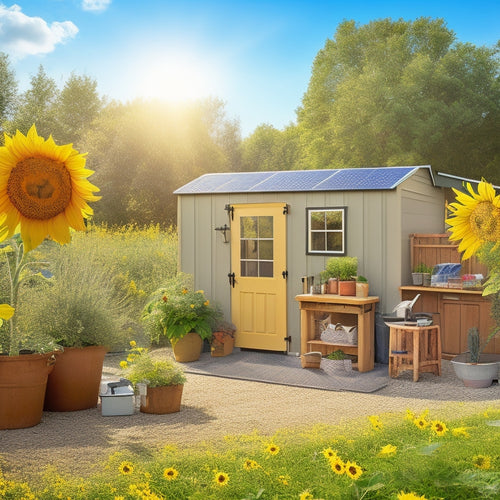
5 Ways to Cut Home Renewable Costs
Share
By implementing a few key strategies, you can greatly cut the costs of integrating renewable energy into your home. You can start by optimizing your solar panel angle to maximize energy production, choosing efficient energy storage solutions, and reducing your energy consumption habits. Additionally, you can take advantage of government incentives, such as federal tax credits and state rebates, to minimize upfront costs. Finally, selecting cost-effective installation methods, such as professional assessments, can yield long-term savings. By exploring these options further, you'll be well on your way to making your renewable energy system more affordable and effective.
Key Takeaways
- Optimize solar panel angle for ideal orientation between 30-40 degrees to maximize energy production and reduce costs.
- Select the most efficient energy storage option based on capacity needs and energy management requirements to minimize expenses.
- Reduce energy consumption habits by replacing incandescent bulbs, upgrading to ENERGY STAR appliances, and practicing mindful consumption.
- Research and maximize government incentives, such as federal tax credits and state rebates, to minimize upfront costs.
- Consider hiring professionals for installation to ensure maximum efficiency, effectiveness, and long-term savings over DIY methods.
Optimize Your Solar Panel Angle
With your solar panel system installed, maximizing energy production is vital to reap the benefits of renewable energy. To do so, you'll need to refine your solar panel angle. The ideal solar panel orientation is between 30-40 degrees, but this can vary depending on your location and the time of year.
It's also important to verify that your panel's structural integrity can support the installation, and that you're compliant with local building codes.
seasonal adjustments Seasonal adjustments are essential to guarantee peak energy production. During summer, adjust your panels to a steeper angle to capture more direct sunlight. In winter, adjust them to a shallower angle to capture more indirect sunlight.
Choose Efficient Energy Storage
You've invested in a solar panel system, and now it's time to evaluate how to store the excess energy it produces. Choosing the right energy storage solution can markedly cut your renewable energy costs. With advancements in battery technology, you have various options to select from. Consider the following factors to make an informed decision:
| Energy Storage Option | Capacity (kWh) | Cost (USD/kWh) |
| Lead-Acid Battery | 2-4 | 150-200 |
| Lithium-Ion Battery | 4-12 | 250-350 |
| Saltwater Battery | 4-8 | 200-300 |
| Flow Battery | 10-20 | 300-400 |
| Nickel-Cadmium Battery | 2-4 | 200-250 |
When selecting an energy storage solution, consider your energy management needs and the capacity you require. By choosing the right option, you can optimize your energy storage and reduce your renewable energy costs.
Reduce Energy Consumption Habits
One essential aspect of maximizing renewable cost savings is to reduce energy consumption habits. You can start by replacing traditional incandescent bulbs with LEDs, which use considerably less energy.
Additionally, swap out old appliances for energy efficient ones, such as those with the ENERGY STAR label. This will help reduce your overall energy consumption.
By incorporating Energy Efficient Smart Thermostats and Automated Temperature Control into your home, you can further optimize your energy usage.
Practice mindful consumption by turning off lights, electronics, and appliances when not in use. You can also adjust your daily habits, like taking shorter showers and washing clothes in cold water.
Maximize Government Incentives Today
Since the shift to renewable energy sources is a relatively new concept, governments worldwide are offering attractive incentives to encourage individuals and businesses to make the change.
You can benefit from these incentives by maximizing federal tax credits and state rebates. For instance, you may be eligible for a federal tax credit of up to 30% of the total cost of your renewable energy system. Additionally, many states offer rebates that can further reduce your upfront costs.
As you evaluate manufacturer reputation, research the specific incentives available in your area and factor them into your budget to minimize your out-of-pocket expenses.
Select Cost-Effective Installation Methods
Maximizing government incentives is just the first step in reducing the cost of renewable energy.
Now, you need to select cost-effective installation methods to further cut costs. You have two primary options: DIY installations or hiring a professional.
While DIY installations may seem like a cost-effective approach, they can lead to errors, safety risks, and even void your warranty.
On the other hand, professional assessments can provide you with a customized solution designed to meet your specific energy needs, ensuring maximum efficiency and savings.
Consider hiring a professional to assess your energy requirements and recommend the most suitable installation method.
This approach may require an initial investment, but it can lead to long-term savings and a more efficient renewable energy system.
Frequently Asked Questions
Can I Install Renewable Energy Systems Myself to Save Money?
You can install renewable energy systems yourself, but it's essential to weigh the benefits against potential risks and intricacies. While DIY installation might seem like a cost-effective solution, it may void warranties or lead to safety hazards if not done correctly.
How Long Does It Take to See a Return on Renewable Energy Investment?
Imagine harvesting free energy from the sun or wind, and wondering when you'll break even. You'll typically see a return on your renewable energy investment within 5-15 years, depending on your location and system size, after conducting a thorough investment analysis to determine the payback period.
Are There Financing Options Available for Renewable Energy Systems?
You'll find various financing options for renewable energy systems, including government incentives and specialized programs; for instance, the Federal Solar Investment Tax Credit (ITC) offers a 26% tax credit, while state-specific financing programs provide low-interest loans and grants.
Can I Sell Excess Energy Generated Back to the Grid?
You're sitting on a goldmine of excess energy! With net metering, you can sell it back to the grid and rake in energy credits, offsetting your utility bills - it's a win-win for your wallet and the environment!
Do Renewable Energy Systems Require Frequent Maintenance?
You'll be relieved to know that renewable energy systems require minimal maintenance, with most components lasting 20-30 years or more, and maintenance frequency directly impacting system longevity, so regular checks guarantee peak performance and extended lifespan.
Related Posts
-

Net Metering in Renewable Energy's Future
Net metering's future is vital for driving renewable energy growth and financial savings. You can reduce your electri...
-

Building an Emergency Backup Solar Power System in 5 Essential Steps
Building an emergency backup solar power system involves five key steps. First, assess your daily energy needs to ide...
-

Designing a Green Roof for Maximum Energy Efficiency
Designing a green roof for maximum energy efficiency involves several key strategies. Start by selecting native, drou...


